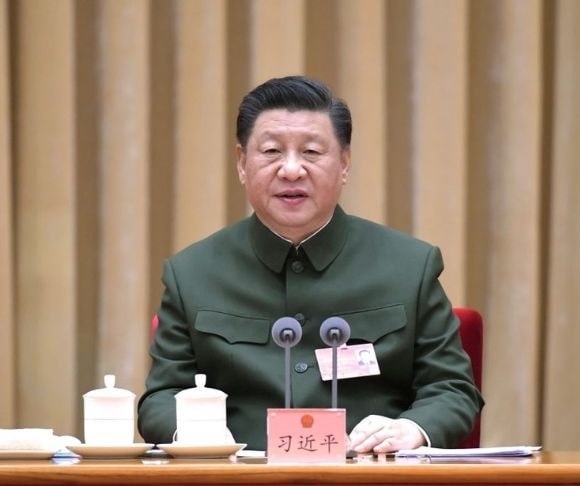China is on the move everywhere. So, what does the US strategy to impede the Chinese Communist Party’s (CCP) march across the globe look like? So far it appears soft, which means the United States must develop a more tailored plan of action to modify the CCP’s hegemonic behavior. Even the US Defense Department is beginning to get the message that China is a dangerous and aggressive player on the world stage. It’s time to do more than wave the climate change flag and address the real threat.
Trump’s China Strategy
 When former President Donald Trump entered the White House, many urged a new China strategy to counter the People’s Republic of China’s (PRC) notion of world dominance. The United States, its friends, and allies in the Pacific needed a more confrontational policy short of a shooting war. To that end, within a year the Trump administration published its National Security Strategy (NSC), which accurately characterized China as a national security threat and took a broader, whole-of-government approach. “[Trump] called for suspending more Chinese student visas under the auspices of curbing espionage … announced the end of special economic treatment for Hong Kong and the sanctioning of officials who restrict freedoms in the territory,” a June 2020 War on the Rocks article reported. He put tariffs on Chinese products and increased defense spending focused on defeating the People’s Liberation Army (PLA) militarily. Trump had the right instincts.
When former President Donald Trump entered the White House, many urged a new China strategy to counter the People’s Republic of China’s (PRC) notion of world dominance. The United States, its friends, and allies in the Pacific needed a more confrontational policy short of a shooting war. To that end, within a year the Trump administration published its National Security Strategy (NSC), which accurately characterized China as a national security threat and took a broader, whole-of-government approach. “[Trump] called for suspending more Chinese student visas under the auspices of curbing espionage … announced the end of special economic treatment for Hong Kong and the sanctioning of officials who restrict freedoms in the territory,” a June 2020 War on the Rocks article reported. He put tariffs on Chinese products and increased defense spending focused on defeating the People’s Liberation Army (PLA) militarily. Trump had the right instincts.
Finally, Biden’s Defense Department Pays Attention
During a military visit to Indonesia on July 24, Chairman of the Joint Chiefs of Staff Mark Milley admitted to reporters that China was a real threat. “The message is the Chinese military, in the air and at sea, have become significantly more and noticeably more aggressive in this particular region … They’re trying to expand their influence throughout the region.” These comments were consistent with what Secretary of Defense Lloyd Austin told the press in June during his trip to Singapore. He pointed out there has been an “alarming increase in the number of unsafe aerial intercepts and confrontations at sea by PLA aircraft and vessels.” Both US military leaders described an increasingly dangerous environment in the Indo-Pacific region caused by Beijing’s aggressive behavior.

Joe Biden (Photo by David L. Ryan/The Boston Globe via Getty Images)
As in most 12-step self-help programs, admitting there is a problem is the first step. Previously the Biden administration referred to China as the “pacing challenge” and an economic threat. The latest language from Milley and Austin seemed to walk back those terms. Though some “inside-the-beltway” defense pundits may have missed the significance, the administration going forward with the Trump initiative to join Britain in selling nuclear submarines and associated technology to Australia significantly enhances defense in the Pacific region generally and Taiwan specifically. Australia scrapped a contract with France for 12 diesel-powered submarines requiring frequent surfacing to charge batteries in favor of eight nuclear-powered vessels able to stay submerged for months.
The strategic value of having Australian nuclear boats in the South China Sea, operating stealthily for extended periods, is immense. The United States and its Australian ally could engage with surprise Chinese combatants moving to attack Taiwan. The Australian atomic-powered boats would be close to home ports and could deploy quickly in the straits between Taiwan and China. Such an underwater armada alone could render the Chinese navy ineffective at a sea-borne invasion or sea battle. It’s just a single node in an overall strategy, but Taiwan’s defense is paramount to halt Beijing’s plan to subjugate the island nation as it did Hong Kong.
A China Strategy Requirement
 An integrated China strategy includes allied surface navies and improved strategic and tactical air forces. A recent Pacific region-centered wargame conducted by the US Air Force showed it would require a “mix of aircraft, drones, networks and other weapons systems it will need in the next decade if it hopes to beat China in a potential war,” according to Defense News. Also critical is an enormous logistical supply chain of cargo ships and the rapid resupply provided by cargo aircraft and air mobility assets airlanding or airdropping men and equipment. Weapons and command and control systems must be interoperable and networked with regional allies and friends.
An integrated China strategy includes allied surface navies and improved strategic and tactical air forces. A recent Pacific region-centered wargame conducted by the US Air Force showed it would require a “mix of aircraft, drones, networks and other weapons systems it will need in the next decade if it hopes to beat China in a potential war,” according to Defense News. Also critical is an enormous logistical supply chain of cargo ships and the rapid resupply provided by cargo aircraft and air mobility assets airlanding or airdropping men and equipment. Weapons and command and control systems must be interoperable and networked with regional allies and friends.
An effective strategy will create a bulwark around China from geopolitical, military, and economic perspectives. When the Biden administration achieves gravitas in the Indo-Pacific, China will cease making bellicose and aggressive moves against Taiwan and other Pacific neighbors.
The views expressed are those of the author and not of any other affiliation.




